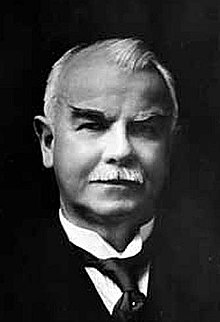James Alfred Ewing
Sir James Alfred Ewing (born March 27, 1855 in Dundee , Scotland ; † January 7, 1935 in Cambridge , Cambridgeshire ) was a Scottish physicist and engineer who primarily researched the magnetic properties of metals and the later generalized term of Hysteresis shaped.
Life
Ewing was born the third son of a clergyman in the Free Church of Scotland and attended the West End Academy and the High School of Dundee , where he showed an early interest in physics, chemistry and technology, making him an outsider in a literary and clerical family took.
He graduated as an engineer from the University of Edinburgh , where he studied under William Thomson , later Lord Kelvin, and Peter Guthrie Tait . During the holidays he worked on telegraph cable laying expeditions under Thomson and Fleeming Jenkin , including in Brazil.
In 1878 he followed the call to participate in the modernization of Japan after the end of the Meiji period as o-yatoi gaikokujin ("recruited foreigner"). He became a professor of engineering mechanics at the University of Tokyo and founded seismological research in Japan. At Tokyo University, Ewing u. a. to Basil Hall Chamberlain , Thomas Henry James , Henry Dyer (1848–1918) and William Edward Ayrton .
In Tokyo, Ewing gave courses in mechanics and the theory of heat engines for engineering students, and lectures on electricity and magnetism for budding physicists. He did research in the field of magnetism, where he developed the concept of hysteresis. In addition, he dealt with earthquake research, where he worked with Thomas Lomar Gray (1850-1908) and John Milne . They developed new seismographs, with Milne being credited with inventing the first modern horizontal pendulum seismograph .
In 1883 Ewing returned to Scotland and worked from then on at Dundee University College. He found poor living conditions in many parts of the city and tried to improve the situation together with the local authorities and local industrialists.
Seven years later, in 1890, he was appointed professor of applied mechanics at King's College , Cambridge. There he researched the magnetization of metals and questioned Wilhelm Weber's classic approach . In 1890 he discovered that the magnetization of metals in alternating currents follows the current and does not return to its original state. He described the hysteresis curve and considered the magnetism of the individual molecules. He also dealt with the crystalline structure of metals. Together with his friend Charles Algernon Parsons , he developed a new type of turbine.
In 1903 he was appointed director of naval training at the Admiralty. In 1916 he was finally Vice Chancellor of the University of Edinburgh , which he remained until his retirement in 1929.
Honors
- Member ("Fellow") of the Royal Society of Edinburgh (1878);
- Member ("Fellow") of the Royal Society (1887);
- Royal Medal of the Royal Society (1895);
- CB (1907);
- KCB (1911);
- President of the Royal Society of Edinburgh (1924–1929);
- Albert Medal of the Royal Society of Arts (1929);
- President of the British Association for the Advancement of Science (1932);
- The Institution of Civil Engineers has awarded the James Alfred Ewing Medal since 1938 for particularly meritorious research contributions in the engineering sciences.
Work
- Treatise on Earthquake Measurement (1883)
- Magnetic Induction in Iron and Other Metals (1891)
- The Steam Engine and other Heat Engines (1894)
- The Strength of Materials (1899)
- The Mechanical Production of Gold (1908)
- Thermodynamics for Engineers (1920).
bibliography
- Bates, LF (1946) Sir Alfred Ewing: A Pioneer in Physics and Engineering ISBN 1-11451704-6
- Pedlar, Neil, 'James Alfred Ewing and his circle of pioneering physicists in Meiji Japan', Chapter 8, Britain & Japan: Biographical Portraits Volume III, ed. JE Hoare, Japan Library, 1999. ISBN 1-87341089-1
| personal data | |
|---|---|
| SURNAME | Ewing, James Alfred |
| ALTERNATIVE NAMES | Ewing, Sir James Alfred (full name) |
| BRIEF DESCRIPTION | Scottish physicist and engineer |
| DATE OF BIRTH | March 27, 1855 |
| PLACE OF BIRTH | Dundee , Scotland |
| DATE OF DEATH | January 7, 1935 |
| Place of death | Cambridge |
